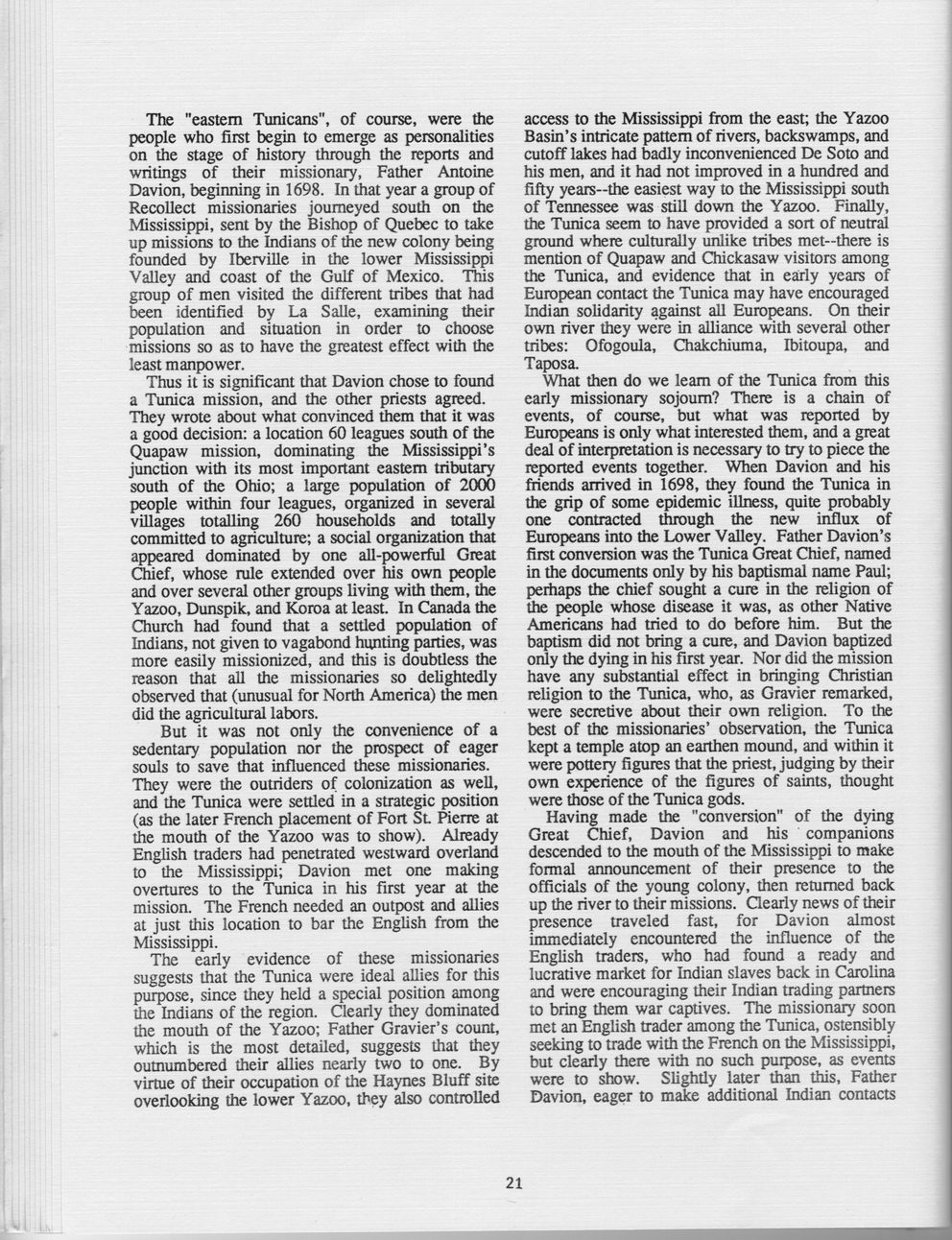This text was obtained via automated optical character recognition.
It has not been edited and may therefore contain several errors.
The "eastern Tunicans", of course, were the people who first begin to emerge as personalities on the stage of history through the reports and writings of their missionary, Father Antoine Davion, beginning in 1698. In that year a group of Recollect missionaries journeyed south on the Mississippi, sent by the Bishop of Quebec to take up missions to the Indians of the new colony being founded by Iberville in the lower Mississippi Valley and coast of the Gulf of Mexico. This group of men visited the different tribes that had been identified by La Salle, examining their population and situation in order to choose missions so as to have the greatest effect with the least manpower. Thus it is significant that Davion chose to found a Tunica mission, and the other priests agreed. They wrote about what convinced them that it was a good decision: a location 60 leagues south of the Quapaw mission, dominating the Mississippi’s junction with its most important eastern tributary south of the Ohio; a large population of 2000 people within four leagues, organized in several villages totalling 260 households and totally committed to agriculture; a social organization that appeared dominated by one all-powerful Great Chief, whose rule extended over his own people and over several other groups living with them, the Yazoo, Dunspik, and Koroa at least. In Canada the Church had found that a settled population of Indians, not given to vagabond hunting parties, was more easily missionized, and this is doubtless the reason that all the missionaries so delightedly observed that (unusual for North America) the men did the agricultural labors. But it was not only the convenience of a sedentary population nor the prospect of eager souls to save that influenced these missionaries. They were the outriders of colonization as well, and the Tunica were settled in a strategic position (as the later French placement of Fort St. Pierre at die mouth of the Yazoo was to show). Already English traders had penetrated westward overland to the Mississippi; Davion met one making overtures to the Tunica in his first year at the mission. The French needed an outpost and allies at just this location to bar the English from the Mississippi. The early evidence of these missionaries suggests that the Tunica were ideal allies for this purpose, since they held a special position among the Indians of the region. Clearly they dominated the mouth of the Yazoo; Father Gravier’s count, which is the most detailed, suggests that they outnumbered their allies nearly two to one. By virtue of their occupation of the Haynes Bluff site overlooking the lower Yazoo, they also controlled access to the Mississippi from the east; the Yazoo Basin’s intricate pattern of rivers, backswamps, and cutoff lakes had badly inconvenienced De Soto and his men, and it had not improved in a hundred and fifty years—the easiest way to the Mississippi south of Tennessee was still down the Yazoo. Finally, the Tunica seem to have provided a sort of neutral ground where culturally unlike tribes met—there is mention of Quapaw and Chickasaw visitors among the Tunica, and evidence that in early years of European contact the Tunica may have encouraged Indian solidarity against all Europeans. On their own river they were in alliance with several other tribes: Ofogoula, Chakchiuma, Ibitoupa, and Taposa. What then do we leam of the Tunica from this early missionary sojourn? There is a chain of events, of course, but what was reported by Europeans is only what interested them, and a great deal of interpretation is necessary to try to piece the reported events together. When Davion and his friends arrived in 1698, they found the Tunica in the grip of some epidemic illness, quite probably one contracted through the new influx of Europeans into the Lower Valley. Father Davion’s first conversion was the Tunica Great Chief, named in the documents only by his baptismal name Paul; perhaps the chief sought a cure in the religion of the people whose disease it was, as other Native Americans had tried to do before him. But the baptism did not bring a cure, and Davion baptized only the dying in his first year. Nor did the mission have any substantial effect in bringing Christian religion to the Tunica, who, as Gravier remarked, were secretive about their own religion. To the best of the missionaries’ observation, the Tunica kept a temple atop an earthen mound, and within it were pottery figures that the priest, judging by their own experience of the figures of saints, thought were those of the Tunica gods. Having made the "conversion" of the dying Great Chief, Davion and his companions descended to the mouth of the Mississippi to make formal announcement of their presence to the officials of the young colony, then returned back up the river to their missions. Clearly news of their presence traveled fast, for Davion almost immediately encountered the influence of the English traders, who had found a ready and lucrative market for Indian slaves back in Carolina and were encouraging their Indian trading partners to bring them war captives. The missionary soon met an English trader among the Tunica, ostensibly seeking to trade with the French on the Mississippi, but clearly there with no such purpose, as events were to show. Slightiy later than this, Father Davion, eager to make additional Indian contacts 21

Native Americans The-Tunica-Biloxi-Tribe-its-Culture-and-People-(28)